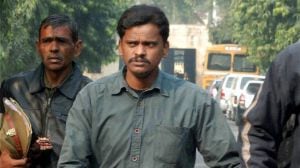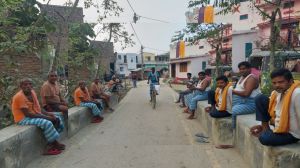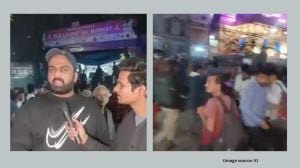Sultans of Swing
...

Until the 1980s, who knew peanuts about Sufi music? Except in Kashmir and Punjab, or in the inner world of baateen (esoteric) Islam, in Delhi, in Nagaur, in Lucknow, Hyderabad and Bhopal, in Kerala, Karnataka and Tamil Nadu, at secret samas (Sufi musical gatherings)?
Only in the folkways of undivided Punjab-Sindh and the Kashmir valley were Sufi songs well-known and part of mela-dargah-urs culture, because, as Abida Parveen of Pakistan says, “Wohi toh belt hai. Sab piraan wohin ke the.” (That’s the Sufi belt, all the saints were from that region).
In the Punjabi diaspora that settled in Delhi, a few private mehfils sustained Sufi music through the 1960s and 1970s, led by people like the late singer Naina Devi and the Kapurthala scions, especially music patroness Anita Singh, or KK Kohli, the man behind Impresario Asia that specialises in Sufi and Punjabi musical programmes and still hold private gatherings at each other’s houses to hear, say, a Husain Bux of Pakistan.
Or else you had a sitar virtuoso like Mahmood Mirza of Delhi who settled in England and organised a display of dancing dervishes from Iran at Cambridge in the 1970s, “The first time I ever saw such a thing!” reveals Kohli. Outside these circles, Naseeruddin Shah’s uncle, expat writer Idrees Shah of Sardana near Meerut, had begun to impact urban Indian readers in the 1970s with books like The Way of the Sufi and Thinkers of the East, but nobody knew the words outside Punjabi, Urdu and Kashmiri circles. So geography remained history until a cross-border invasion happened. Leading the march was the portly figure of the late Nusrat Fateh Ali Khan, who blasted Indian ears with mystic verse sung on turbo. A fad was born, reinforced by more Pakistanis like the Sabri Brothers and Abida Parveen, as portly and powerful as Nusrat, yet exclusive in appeal to concert-goers.
Sufi mania gripped the metros and led to Sufi-focused events like Muzaffar Ali’s ‘Jehan-e-Khusrau’ at Arab ki Serai near Humayun’s Tomb in Delhi, now in its third year as a cultural event. Another awaited annual concert in Mumbai is Banyan Tree’s Ruhaniyat, with acclaimed Sufi musicians like the Nizami Brothers.
There was a renewal of interest in Khusrawi mausiki across India, with fresh fizz in the songs of this medieval disciple of Hazrat Nizamuddin, who invented the tabla and sitar besides leaving a vast body of verse. Music Today packaged the Wadali Brothers of Punjab, Reshma of Pakistan, the Warsi Brothers in qawwali, and Punjabi pop leapt beyond bhangra-rap with Hansraj Hans and troupes. And singer Jassi—whose bigtime hit is Dil Legayi Kudi Gujarat Ki—shyly reveals, “Actually I like to sing Sufiyana as my offering at dargahs and ziyarats, but it was a private interest for years without public demand, until today.”
Abida’s album, Songs of the Mystics, sold the max in audio-cassettes at 6,917 while Nusrat’s Traditional Sufi Qawwalis Volume 2 sold 5,937. And Nusrat’s Volume 4 in that series sold the most CDs of any Sufi singer at 1,649.
Composer AR Rahman, a Hindu who always seems to specify that he “converted to Sufism”, has a reason for the inner connection with Sufi music under the present fad: “Sufi music is a way to feel the One-ness of the Almighty (Tauheed), to spread love and peace through the incantations and the thoughts of their lyrics, and to discover Divinity with a cleansed heart. Different states of India have their own flavour of Sufi music: Punjab’s Baba Bulleshah was the inspiration for Chhaiya Chhaiya. My favourites are Hazrat Amir Khusrau, Jalaluddin Rumi, Shams Tabriz and Baba Bulleshah”.
Rahman remains discreetly silent on the prevailing commercial fad of ‘Sufism’. But while those God-intoxicated beggar-mystics of yore may prefer less noise and more practical seva as a mark of affection for the Sufi path, the public is grooving anyway to their songs with pan-Indian comfort levels inspired so far only by bhangra and Hindi film music.
(With inputs from Lalitha Suhasini in Mumbai)
LET ’EM KNOW YOU KNOW
An instafix on Sufism for mehfils and baithaks, to put down the show-off sprawled on the next gau-takia
• At the next Wadali Brothers private concert, ask for a verse by Shah Hussain. Say, Rabba Mere Augun Chit Na Dharin. When Puranchand and Pyarelal turn purple and refuse, look around and smirk: “Isn’t that too bad? Just because they were gay, poor things!” When the clamour subsides, explain that Shah Hussain is the takhallus (nom de plume) of Madho Lal and his lover Hussain. When GGS (Guru Gobind Singhji) was compiling the Guru Granth Sahib, the couple sent in their verses for inclusion, which were turned down as too scandalous in origin.
• Dress in ‘suf’, woollen robes from which the original Sufis may have got their name. Kashmiri phirans won’t do, you need nubby yardage in goat hair mixed with merino, trimmed with camel hair thread. The silhouette has to be asymmetrical and the palette strictly tone-on-tone in a gamut of taupe, greige and ivory. Sienna and crimson allowed as accents. Emerald with a filigree crescent brooch is overly PC: what are you, a samosa-hurling Sehmat spy?
• Between your next single malt and kakori, strive to appear fana (in mystic union with the music). You can avoid flying arse-over-kettle if you skip the dip between mattresses and select steady ground on which to sway and clap. Move on to a meditative turn, after which, shut your eyes and execute three swift, neat twirls.
• Buy Coleman Barks’s translation of Rumi (as in Maulana Jalaluddin) and mug up two significant lines to drop at each gathering (Barks’s translation, though wrong in places, has made Pops Rumi the Number One poet in America).
• If you study Pops Rumi’s love life, you’re set, you don’t need JLo’s. Rumi was a hot mullah who got felled by a Sufi lightning bolt. The vajra was a guy called Shams Tabrizi, who never wrote a line in his life and was bad-mannered to boot, with a monster ego. Everybody around was mad at Shams for hijacking Rumi, and one day a gang of assassins put him out. Rumi went berserk looking for him, found another ‘friend’ called Husain Chalebi and wrote three books: the monumental Mathnavi (a sort of Koran in Persian, full of meaningful folk tales, including lots from Hind); the Diwan-e-Shams Tabrizi, which is a big bunch of ecstatic poems written in the name of his lost beloved and Fihi ma Fihi (In It What’s In It), a string of reflections. What YOU need to say in a dreamy, meditative tone: “In looking for Shams, Rumi found himself!” Your rep as a Profound Person will be secured for all time.



- 01
- 02
- 03
- 04
- 05




























